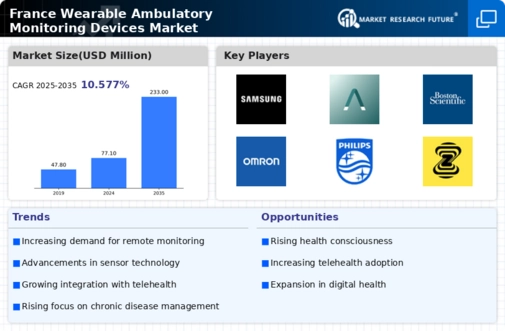Growing Aging Population
The growing aging population in France is a significant driver of the wearable ambulatory-monitoring-devices market. As the demographic landscape shifts, with an increasing number of individuals aged 65 and older, the demand for health monitoring solutions is expected to rise. By 2025, it is estimated that over 20% of the French population will fall into this age category, leading to a heightened need for devices that can monitor vital signs and chronic conditions. This demographic shift is prompting healthcare providers to adopt wearable technologies that facilitate remote monitoring, thereby allowing elderly patients to maintain their independence while ensuring their health is closely monitored. this market is thus poised for growth, as these devices become essential tools for managing the health of an aging population.
Supportive Government Initiatives
Supportive government initiatives play a crucial role in the growth of the wearable ambulatory-monitoring-devices market in France. The French government has been actively promoting digital health solutions as part of its broader healthcare strategy. Initiatives aimed at integrating technology into healthcare systems are likely to enhance the adoption of wearable devices. In 2025, government funding for digital health projects is expected to exceed €200 million, facilitating research and development in this sector. Such support not only encourages innovation but also fosters collaboration between technology companies and healthcare providers. As a result, the wearable ambulatory-monitoring-devices market is expected to benefit from these initiatives, leading to increased accessibility and affordability of advanced health monitoring solutions.
Integration of Artificial Intelligence
The integration of artificial intelligence (AI) into wearable ambulatory-monitoring-devices is transforming the landscape of healthcare in France. AI technologies enhance the functionality of these devices by enabling advanced data analytics and personalized health insights. In 2025, it is projected that AI-driven wearable devices will account for nearly 30% of the total market share, indicating a substantial shift towards intelligent health monitoring solutions. This integration allows for predictive analytics, which can identify potential health issues before they escalate. As a result, healthcare providers can offer more tailored treatment plans, improving patient engagement and adherence to prescribed therapies. The wearable ambulatory-monitoring-devices market is thus likely to benefit from this technological evolution, as consumers increasingly seek devices that offer not just monitoring, but also actionable health insights.
Increased Focus on Preventive Healthcare
The increased focus on preventive healthcare is driving the wearable ambulatory-monitoring-devices market in France. As healthcare systems evolve, there is a growing recognition of the importance of prevention over treatment. This shift is reflected in the rising adoption of wearable devices that empower individuals to take charge of their health. In 2025, it is anticipated that the preventive healthcare segment will represent approximately 40% of the overall market, as consumers seek to monitor their health proactively. Wearable devices that track physical activity, heart rate, and other vital metrics are becoming commonplace, enabling users to make informed lifestyle choices. Consequently, the wearable ambulatory-monitoring-devices market is likely to expand as more individuals embrace these technologies to enhance their well-being and prevent potential health issues.
Rising Demand for Remote Patient Monitoring
The increasing demand for remote patient monitoring is a pivotal driver in the wearable ambulatory-monitoring-devices market. As healthcare systems in France strive to enhance patient care while reducing costs, the adoption of wearable devices has surged. In 2025, it is estimated that the market for remote monitoring devices will reach approximately €1.5 billion, reflecting a growth rate of around 15% annually. This trend is largely fueled by the need for continuous health monitoring, especially for chronic conditions such as diabetes and cardiovascular diseases. Patients and healthcare providers alike are recognizing the benefits of real-time data collection, which can lead to timely interventions and improved health outcomes. Consequently, the wearable ambulatory-monitoring-devices market is positioned to expand significantly as more healthcare facilities integrate these technologies into their practices.
























Leave a Comment